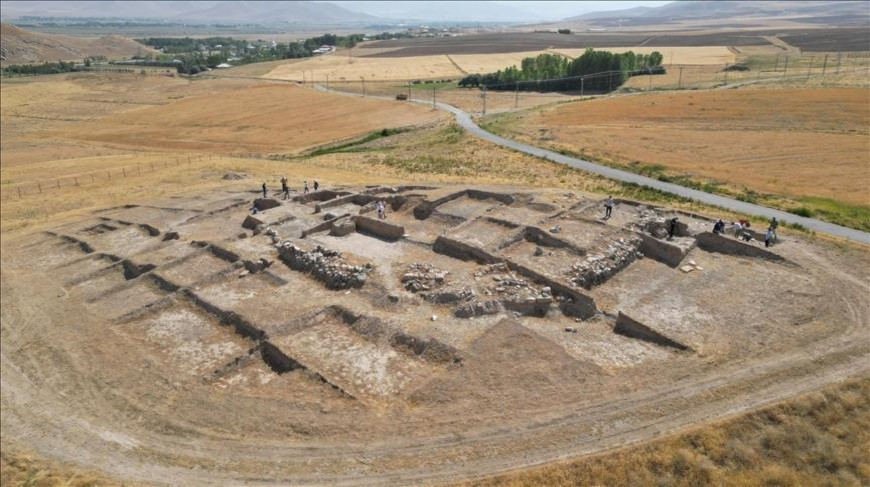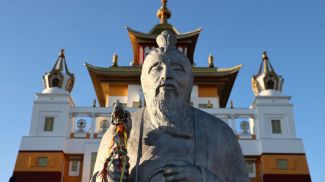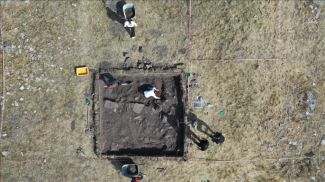
VAN/ISTANBUL, 24 July (BelTA - Anadolu) - Archaeologists working in an
ancient Urartian necropolis in eastern Türkiye’s Van province are
uncovering remarkable evidence of Urartian burial traditions, including
signs that women may have held high status in the Iron Age kingdom.
Excavations resumed earlier this year at the Cavustepe Castle that was constructed by Urartian King Sarduri II between 764 and 734 BC, and at the necropolis to its north -- the area containing cemeteries and mass graves -- with the permission of the Culture and Tourism Ministry.
Despite scorching temperatures and swirling dust, a team led by Rafet Cavusoglu, head of the archaeology department at Van Yuzuncu Yil University, is carefully revealing layers of history buried for more than two millennia.
The team uncovered human skeletons and ceramic artifacts within the necropolis, where members of the ruling class are believed to have been buried. The finds are expected to provide new insights into the social and economic lives of Urartian elites and their burial customs.
Encountered burial traditions
Cavusoglu told Anadolu that the excavation team has made remarkable discoveries about Urartian burial practices.
They have been excavating the necropolis for nine years and have encountered more than one burial tradition, said Cavusoglu.
“We can understand how tolerant the Urartian society, or the people who lived in Cavustepe Castle, were in terms of religious beliefs by examining their burial customs. So far, we have encountered more than 50 inhumation burials. In addition to these, we have also witnessed individuals being buried alongside horses and dogs. Moreover, we see urn-type graves in which the deceased, ranging from children to young women and middle-aged individuals, were cremated before burial.”
One of the most striking discoveries this season has been the recovery of seals placed with female skeletons, suggesting that women in Urartian society may have held administrative or decision-making roles, he said.
“In Urartian culture, especially at Cavustepe, women carrying seals show they were part of the ruling class and they had a say in society,” said Cavusoglu. “It is quite intriguing for us that they held decision-making positions.”
He added that some graves feature joint burials of men and women, indicating the prominence of nuclear families and monogamy, rather than polygamous household structures.
Children also appear to have been highly valued, often adorned with jewelry in death, he said.
“As always, we are encountering new findings that surprise us. Since each burial tradition reveals a different custom, along with distinct jewelry and ornate objects, we believe this year’s excavations will once again hold surprises,” Cavusoglu added.
Excavations resumed earlier this year at the Cavustepe Castle that was constructed by Urartian King Sarduri II between 764 and 734 BC, and at the necropolis to its north -- the area containing cemeteries and mass graves -- with the permission of the Culture and Tourism Ministry.
Despite scorching temperatures and swirling dust, a team led by Rafet Cavusoglu, head of the archaeology department at Van Yuzuncu Yil University, is carefully revealing layers of history buried for more than two millennia.
The team uncovered human skeletons and ceramic artifacts within the necropolis, where members of the ruling class are believed to have been buried. The finds are expected to provide new insights into the social and economic lives of Urartian elites and their burial customs.
Encountered burial traditions
Cavusoglu told Anadolu that the excavation team has made remarkable discoveries about Urartian burial practices.
They have been excavating the necropolis for nine years and have encountered more than one burial tradition, said Cavusoglu.
“We can understand how tolerant the Urartian society, or the people who lived in Cavustepe Castle, were in terms of religious beliefs by examining their burial customs. So far, we have encountered more than 50 inhumation burials. In addition to these, we have also witnessed individuals being buried alongside horses and dogs. Moreover, we see urn-type graves in which the deceased, ranging from children to young women and middle-aged individuals, were cremated before burial.”
One of the most striking discoveries this season has been the recovery of seals placed with female skeletons, suggesting that women in Urartian society may have held administrative or decision-making roles, he said.
“In Urartian culture, especially at Cavustepe, women carrying seals show they were part of the ruling class and they had a say in society,” said Cavusoglu. “It is quite intriguing for us that they held decision-making positions.”
He added that some graves feature joint burials of men and women, indicating the prominence of nuclear families and monogamy, rather than polygamous household structures.
Children also appear to have been highly valued, often adorned with jewelry in death, he said.
“As always, we are encountering new findings that surprise us. Since each burial tradition reveals a different custom, along with distinct jewelry and ornate objects, we believe this year’s excavations will once again hold surprises,” Cavusoglu added.













